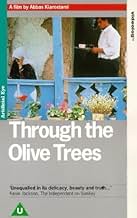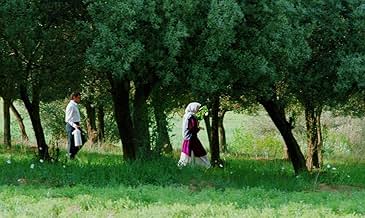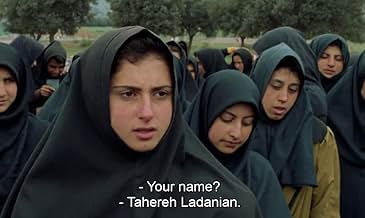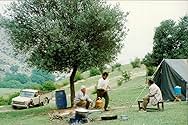AVALIAÇÃO DA IMDb
7,7/10
11 mil
SUA AVALIAÇÃO
Adicionar um enredo no seu idiomaA depiction of the off-screen relationship between the actors who play the newlyweds in the film E a Vida Continua (1992).A depiction of the off-screen relationship between the actors who play the newlyweds in the film E a Vida Continua (1992).A depiction of the off-screen relationship between the actors who play the newlyweds in the film E a Vida Continua (1992).
- Direção
- Roteirista
- Artistas
- Prêmios
- 5 vitórias e 6 indicações no total
Ostadvali Babaei
- Teacher
- (as Astadouli Babani)
Nosrat Bagheri
- Achiz
- (as Nasret Betri)
Khodabakhsh Defaei
- Teacher
- (as Kheda Barech Defai)
Hossein Jafarian
- Hossein
- (não creditado)
Jafar Panahi
- Panahi
- (não creditado)
Avaliações em destaque
Through the Olive Trees is a great example of how neo-realistic techniques can show realism in film making. One personal criticism would be the music, but that is purely personal, and takes nothing away from the film. A masterpeice.
10Red-125
Reviewer's Note: The Iranian movie Zire darakhatan zeyton (1994) was shown in the U.S. with the title Through the Olive Trees. The film was written and directed by Abbas Kiarostami.
The movie is the third of a series of films entitled "The Koker Trilogy." Koker is a small village 200 miles northwest of Tehran. No one outside Iran would know anything about Koker, except for Kiarostami's films. He used Koker as the setting for the first film in the trilogy-Where is the Friend's House? (1987). (This is an amazing movie, with an IMDb rating of 8.1.) However, Koker was still just an obscure village.
Koker is now famous because of a horrible tragedy that took place in the region on June 21, 1990. A devastating earthquake destroyed Koker and many surrounding villages. The loss of life was immense--about 50,000 people died, including 20,000 children. Almost all the buildings were destroyed. Kiarostami directed two more films about Koker. Now, the location is well known to Iranians and cinephiles.
In real life, director Kiarostami and his son traveled to Koker five days after the earthquake occurred. They wanted to find out if the two brothers who starred in the first film had survived the earthquake. Kiarostami turned his trip into a movie. That film was And Life Goes On (1992). He found that despite the immense grief felt by the local people, life did, indeed, go on.
Through the Olive Trees stars Mohamad Ali Keshavarz as The Film Director. He's the only professional actor in any of the three movies. As is usual for Kiarostami, the other actors are local amateurs. Farhad Kheradmand plays Farhad. He was also in And Life Goes On. Zarifeh Shiva portrays Mrs. Shiva, who is the director's assistant.
In this film, Kiarostami has made a movie about making a movie. The movie they are making is And Life Goes On. There's no shortage of movies about making movies. However, I've never seen a movie about making a movie that already exists. It's a brilliant concept, because we can recognize segments of And Life Goes On as they appear in Through the Olive Trees.
However, Through the Olive Trees is really about the relationship of two young people. Hossein Rezai portrays Hossein, who had a four-minute, but important, segment in And Life Goes On. In that segment, he tells us that he and his wife were married the day after the earthquake. They were engaged, the wedding had been planned, and they went ahead with it. This demonstrated a key element of And Life Goes On--the couple embodied the human desire to pick up the pieces and move forward with life, and with replacing death with new life.
In this movie, we learn that Hossain has fallen in love with the woman who played the young wife--Tahereh. However, Tahereh (portrayed by Tahereh Ladanian) apparently wants nothing to do with Hossain. Tahereh lost both of her parents in the earthquake, so she now lives with her grandmother. Her grandmother absolutely rejects Hossain because he's illiterate and doesn't own a house. That makes sense, except that Hossain is intelligent and ambitious, and truly loves the young woman.
So, what we have is a plot within a movie about making a movie. It sounds confusing, but it works.
Kiarostami is famous for using panoramic long shots, and this is what we see at the end of the film. The closing long shot is amazing and unforgettable, but ambiguous.
This is an amazing movie. It has an extremely high IMDb rating of 7.8. I rated it 10. It worked well enough on the small screen, but of course it would be better in a theater. We saw it on a Criterion DVD, sold with the other two movies in the trilogy. The films may be available separately, which would be OK. However, the Criterion edition has many video extras, along with a written essay by noted film critic Godfrey Cheshire.
I would say that the three trilogy movies are all must-see films if you love great international cinema. Find them and watch them.
IMPORTANT: The trilogy should be seen in order of production: Where is the Friend's House? then, And Life Goes On, then, Through the Olive Trees. The movies will each work separately, but they won't work as well if seen out of that order.
The movie is the third of a series of films entitled "The Koker Trilogy." Koker is a small village 200 miles northwest of Tehran. No one outside Iran would know anything about Koker, except for Kiarostami's films. He used Koker as the setting for the first film in the trilogy-Where is the Friend's House? (1987). (This is an amazing movie, with an IMDb rating of 8.1.) However, Koker was still just an obscure village.
Koker is now famous because of a horrible tragedy that took place in the region on June 21, 1990. A devastating earthquake destroyed Koker and many surrounding villages. The loss of life was immense--about 50,000 people died, including 20,000 children. Almost all the buildings were destroyed. Kiarostami directed two more films about Koker. Now, the location is well known to Iranians and cinephiles.
In real life, director Kiarostami and his son traveled to Koker five days after the earthquake occurred. They wanted to find out if the two brothers who starred in the first film had survived the earthquake. Kiarostami turned his trip into a movie. That film was And Life Goes On (1992). He found that despite the immense grief felt by the local people, life did, indeed, go on.
Through the Olive Trees stars Mohamad Ali Keshavarz as The Film Director. He's the only professional actor in any of the three movies. As is usual for Kiarostami, the other actors are local amateurs. Farhad Kheradmand plays Farhad. He was also in And Life Goes On. Zarifeh Shiva portrays Mrs. Shiva, who is the director's assistant.
In this film, Kiarostami has made a movie about making a movie. The movie they are making is And Life Goes On. There's no shortage of movies about making movies. However, I've never seen a movie about making a movie that already exists. It's a brilliant concept, because we can recognize segments of And Life Goes On as they appear in Through the Olive Trees.
However, Through the Olive Trees is really about the relationship of two young people. Hossein Rezai portrays Hossein, who had a four-minute, but important, segment in And Life Goes On. In that segment, he tells us that he and his wife were married the day after the earthquake. They were engaged, the wedding had been planned, and they went ahead with it. This demonstrated a key element of And Life Goes On--the couple embodied the human desire to pick up the pieces and move forward with life, and with replacing death with new life.
In this movie, we learn that Hossain has fallen in love with the woman who played the young wife--Tahereh. However, Tahereh (portrayed by Tahereh Ladanian) apparently wants nothing to do with Hossain. Tahereh lost both of her parents in the earthquake, so she now lives with her grandmother. Her grandmother absolutely rejects Hossain because he's illiterate and doesn't own a house. That makes sense, except that Hossain is intelligent and ambitious, and truly loves the young woman.
So, what we have is a plot within a movie about making a movie. It sounds confusing, but it works.
Kiarostami is famous for using panoramic long shots, and this is what we see at the end of the film. The closing long shot is amazing and unforgettable, but ambiguous.
This is an amazing movie. It has an extremely high IMDb rating of 7.8. I rated it 10. It worked well enough on the small screen, but of course it would be better in a theater. We saw it on a Criterion DVD, sold with the other two movies in the trilogy. The films may be available separately, which would be OK. However, the Criterion edition has many video extras, along with a written essay by noted film critic Godfrey Cheshire.
I would say that the three trilogy movies are all must-see films if you love great international cinema. Find them and watch them.
IMPORTANT: The trilogy should be seen in order of production: Where is the Friend's House? then, And Life Goes On, then, Through the Olive Trees. The movies will each work separately, but they won't work as well if seen out of that order.
I'd just like to disagree with those who suggest this film may not be accessible to people who have not seen the first two films in the trilogy. I haven't, but have not been as bewitched by a film since I saw Aggelopoulos' Travelling Players for the first time. My heart responded, the hairs on the back of my neck responded, my being responded. No matter if my brain wasn't fully au fait with what came before. Superb doesn't begin to cover it. How he captured these (non)performances from his actors is beyond me: perhaps, unfamiliar with the conventions of film-making, they were uniquely equipped to sidestep them.
Michael
Michael
I saw the movie while on vacation in Sweden. Just clicking through TV channels, I stopped on this movie accidentally, initially not paying much attention to it. But the images started to attract me, finally they got hold of me. The realism of everyday life with some strange air of poetic aura was fascinating. The action just floats like a river, no big happenings but pictures are dense, close to skin, close to feelings. The people dreams pour out into daily life. The shaky balance between reality and a dream culminates in the last sequence and we hope for an answer, which is not disclosed but we are left to search it in our imagination and in our dreams evoked by this wonderful movie. Maybe longing for an answer is all what is possible.
First thing: this is the third part in a trilogy. You really need to see "Where is the Friend's House" & "And Life Goes On" first if you want to fully understand this. In short, this is a film about a man making a film of his own journey in search of actors in a film he made earlier. Once you know that, it's not in the least slow or simple, it's a hall of mirrors, as another commentator put it. Frames within frames within frames.
Second thing: Jean-Luc Godard praised Kiarostami's early films, but then felt he'd become too influenced by the international art movie tradition. I don't know if this is a film he liked or disliked, but it sure has a lot of Godard's influence in it - from the director interviewing sundry characters through the conflation of documentary and fiction elements to the use of music, it's like Godard crossed with Satyajit Ray. Not that that's a bad thing.
I don't know if Kiarostami is as original or as striking as some maintain - in many ways this is "Day for Night" transplanted to the Iranian countryside - but it's very watchable, often very funny and the landscape is beautiful.
There also seems to be (in the Iranian context) a subversive subtext to these films. Tradition is held up as hidebound and stupid (the adults in "Where is the Friend's House", the grandmother in this film) while the young are seen improvising their own lives and creating hope in the face of catastrophe. I can't imagine that's too popular with the mullahs, and indeed it seems that Kiarostami has been unable to get a film released in Iran in a decade.
Well worth a view, and it may even inspire you to get out into the world with a digital video camera, but do see the other films (and probably also "Homework") first.
Second thing: Jean-Luc Godard praised Kiarostami's early films, but then felt he'd become too influenced by the international art movie tradition. I don't know if this is a film he liked or disliked, but it sure has a lot of Godard's influence in it - from the director interviewing sundry characters through the conflation of documentary and fiction elements to the use of music, it's like Godard crossed with Satyajit Ray. Not that that's a bad thing.
I don't know if Kiarostami is as original or as striking as some maintain - in many ways this is "Day for Night" transplanted to the Iranian countryside - but it's very watchable, often very funny and the landscape is beautiful.
There also seems to be (in the Iranian context) a subversive subtext to these films. Tradition is held up as hidebound and stupid (the adults in "Where is the Friend's House", the grandmother in this film) while the young are seen improvising their own lives and creating hope in the face of catastrophe. I can't imagine that's too popular with the mullahs, and indeed it seems that Kiarostami has been unable to get a film released in Iran in a decade.
Well worth a view, and it may even inspire you to get out into the world with a digital video camera, but do see the other films (and probably also "Homework") first.
Você sabia?
- CuriosidadesThe first film in which Abbas Kiarostami has hired a professional actor (Mohamad Ali Keshavarz who plays the director of the film-within-the-film).
- ConexõesFeatured in Cinema Iran (2005)
Principais escolhas
Faça login para avaliar e ver a lista de recomendações personalizadas
- How long is Through the Olive Trees?Fornecido pela Alexa
Detalhes
- Data de lançamento
- Países de origem
- Central de atendimento oficial
- Idioma
- Também conhecido como
- Through the Olive Trees
- Locações de filme
- Empresas de produção
- Consulte mais créditos da empresa na IMDbPro
Bilheteria
- Faturamento bruto nos EUA e Canadá
- US$ 40.300
Contribua para esta página
Sugerir uma alteração ou adicionar conteúdo ausente

Principal brecha
By what name was Através das Oliveiras (1994) officially released in India in English?
Responda





















